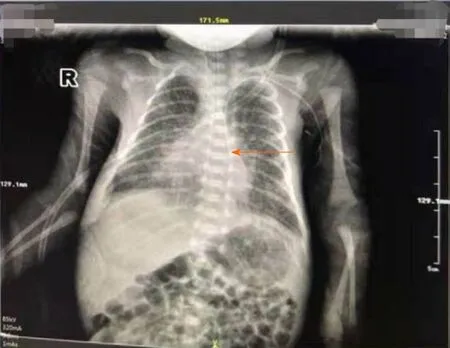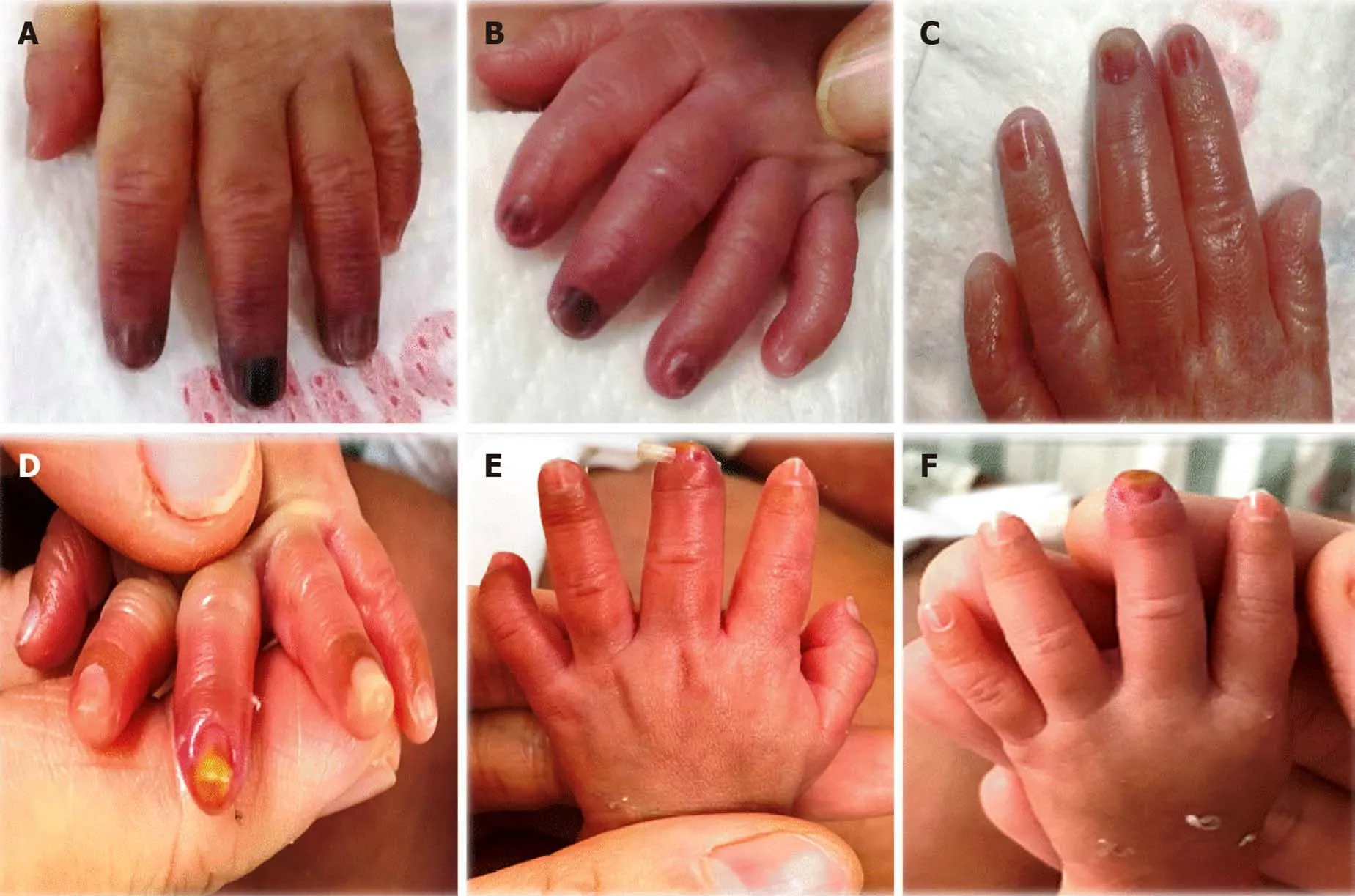Arterial embolism caused by a peripherally inserted central catheter in a very premature infant:A case report and literature review
2020-04-08YiFeiHuangYanLingHuXingLiWanHongChengYaoHuaWuXiaoYanYangJingShi
Yi-Fei Huang,Yan-Ling Hu,Xing-Li Wan,Hong Cheng,Yao-Hua Wu,Xiao-Yan Yang,Jing Shi
Yi-Fei Huang,Yan-Ling Hu,Xing-Li Wan,Hong Cheng,Yao-Hua Wu,Xiao-Yan Yang,Jing Shi,Department of Neonatal Nursing,West China Second University Hospital,Sichuan University,Chengdu 610066,Sichuan Province,China
Yi-Fei Huang,Yan-Ling Hu,Xing-Li Wan,Hong Cheng,Yao-Hua Wu,Xiao-Yan Yang,Jing Shi,Key Laboratory of Birth Defects and Related Diseases of Women and Children,Sichuan University,Chengdu 610066,Sichuan Province,China
Yi-Fei Huang,Yan-Ling Hu,Xing-Li Wan,Hong Cheng,Yao-Hua Wu,Xiao-Yan Yang,Jing Shi,Ministry of Education,West China Nursing School,Sichuan University,Chengdu 610066,Sichuan Province,China
Abstract BACKGROUND Extremely premature infants have poor vascular conditions.Operators often choose deep veins such as the femoral vein and axillary vein to peripherally insert central catheters,and these vessels are often accompanied by arteries;thus,it is easy to mistakenly enter the artery.CASE SUMMARY The case of an extremely premature infant(born at gestational age 28+3)in whom the left upper extremity artery was accidentally entered during peripheral puncture of the central venous catheter is reported.On the 19th day of hospitalization,the index finger,middle finger and ring finger of the left hand were rosy,the left radial artery and brachial artery pulse were palpable,the recovery was 95%,and the improvement was obvious.At discharge 42 d after admission,there was no abnormality in fingertip activity during the follow-up period.CONCLUSION Arterial embolization in preterm infants requires an individualized treatment strategy combined with local anticoagulation and 2% nitroglycerin ointment for local tissue damage caused by arterial embolism in the upper limb.Continuous visualization of disease changes using image visualization increases the likelihood of a good outcome.
Key Words:Arterial thrombosis;Anticoagulation;Nitroglycerin;Peripherally inserted central catheters;Case report
INTRODUCTION
Extremely premature infants have poor vascular conditions.Operators often choose deep veins such as the femoral vein and axillary vein for peripherally inserted central catheters(PICCs),and these vessels are often accompanied by arteries;thus,it is easy to mistakenly enter the artery[1-5].There are methods to follow during and after placement of the tube.During tube placement,there may be clinical manifestations of jet-like,pulsating bright red blood return and high pressure of the flushing tube after mistaken insertion into the artery.If the blood return is not obvious,it is likely that the PICC was successful.Blood gas analysis is performed to check the blood oxygen partial pressure.Generally,the venous blood oxygen partial pressure is lower than that of arterial blood,the carbon dioxide partial pressure is higher than that of arterial blood,and the oxygen saturation is approximately 70%.
If the blood gas analysis results indicate that the blood gas oxygen pressure and the normal percutaneous blood oxygen saturation are extremely similar,it is highly suspected that the artery has been mistakenly entered[6].In addition,an X-ray is needed to confirm the tip position after catheter placement[7-9].
Normal PICC tip positioning for upper limb puncture is usually the middle and lower segment of the superior vena cava 1/3 located on the right side of the spine[10].If the catheter is deflected along the left side of the spine,there are two possibilities:mistaken entry into the arteries or the left permanent superior vena cava.In the case of children with this condition,during the puncture process and after catheter placement,multiple methods should be used to identify the arteries mistakenly entered early and to enable the implementation of proactive measures.
In this study,the case of an extremely premature infant in whom the left upper extremity artery was accidentally entered during peripheral puncture of the central venous catheter is reported.A literature review was also performed.
CASE PRESENTATION
Chief complaints
Eleven days after premature delivery,black and purple coloring of multiple fingers of the left hand was observed.
History of present illness
A male child 11+d was admitted to the hospital on August 14,2019.The infant was born at 28 wk and 3 d of pregnancy with a birth weight of 1100 g and an Apgar score of 5-7-8 points.
History of past illness
Not available.
Physical examination
Multiple fingers on the left hand were black and purple.For further treatment,the infant was transferred to the Neonatal Department of our hospital.On admission,physical examination showed the following:the palm of the left hand was blue and purple;the left index finger,middle finger,and ring finger knuckles were black;the border was unclear;and the local skin temperature was slightly cool.The left radial artery pulsation was not found,and the left brachial artery pulsation was weak.
Laboratory examinations
Blood tests in the laboratory showed that the activated partial thromboplastin time(APTT)was 110.1 s and hemoglobin(HGB)was 132 g/L.
Imaging examinations
Vascular color Doppler ultrasound showed left radial artery embolism and suspected thrombus in the left brachial artery.The patient's chest X-ray film,obtained outside the hospital,showed that the catheter was located on the left side of the spine(PICC)(Figure 1).
FINAL DIAGNOSIS
Left hand fingertip vascular embolism.
TREATMENT
Anticoagulant therapy
On the day of admission,1.5 mg/kg low-molecular-weight heparin sodium was injected subcutaneously(hypodermic injection,ih,q12h.14:33),the APTT was 110.1 s,fg was 148 g/L,and HGB was 132 g/L.The low-molecular-weight heparin sodium dosage was changed to 2.0 mg/kg ih q12h.On the seventh day of admission,the darkened fingertips had improved slightly,but left radial artery pulsation was not found,and the left brachial artery pulsation had weakened.Sodium 2.5 mg/kg,ih,q12h was administered.To correct coagulation function during treatment,the infant was given fresh frozen plasma on the 2ndand 13thdays of admission.
Local treatment
Phentolamine was applied externally on the black and purple parts of the fingers.On the second day of admission,the color of the fingers continued to darken,and the treatment was changed to an external coating of Xiliaotu with a warm saline wet dressing that was replaced every 4 h.On the 5thday of admission,the index finger and ring finger became darker,the middle finger still showed obvious darkening,the left brachial artery pulsation was weakened,and the left radial artery pulsation was still not found.Then,0.2% nitroglycerin ointment was applied with a warm saline wet compress,which was changed every 4 h.
Tracking of the therapeutic effect
Photographs were taken before and aft er each local treatment.The photographs were immediately uploaded to the WeChat Nursing Quality Control Management Group,which is convenient for the timely comparison and tracking of fingertip skin recovery and the modification of treatment plans if necessary.
OUTCOME AND FOLLOW-UP
On the 5thday of admission,the darkened fingertips were slightly better than before.On the 10thday of admission,the left index finger,middle finger,and ring finger turned ruddy,and a yellow-like tissue region of approximately 0.5 cm × 0.3 cm was visible on the fingertips.The left radial artery and brachial artery had weak pulses.On the 14thday of admission,color Doppler ultrasound showed no thrombus in the left upper limb.On the 19thday of admission,the index finger,middle finger,and ring finger of the left hand were rosy,and bruising was visible on the middle fingertips.No exudation or secretions were observed,the left radial/brachial pulsation was palpable,and the degree of recovery was 95%,showing obvious improvement(Figure 2).

Figure 1 The patient's chest X-ray film showed that the catheter was located on the left side of the spine(arrow).
DISCUSSION
The neonatal coagulation system is immature,and coagulation and fibrinolysis maintain a delicate balance.When the balance is disrupted,bleeding or thrombosis easily occurs[11,12].The rates of neonatal thromboembolic diseases reported in Germany and Canada in 1997 were 0.051% and 2.4%,respectively,and a recent study showed that the incidence of neonatal thromboembolic diseases has increased to 6.6%,accounting for 70% of all neonatal mortality[13-15].It has been reported in the literature that 29% of 75 thromboembolic events are due to arterial thrombosis[15],most of which are related to iatrogenic factors such as catheterization and vascular puncture.Saraccoet al[15]showed that the average fetal age at arterial embolism is 31 wk,and Contiet al[13]also noted in the literature that premature infants are at high risk of arterial thrombosis,which is related to factors such as concurrent infections,high blood coagulation status,and the need to puncture arterial blood vessels for blood pressure monitoring or specimen collection during hospitalization[16].This pediatric patient was born at 28 gestational weeks and had a history of puncture.This is consistent with the descriptions of Saraccoet al[15]and Contiet al[13].In 2012,the American Thoracic Association published the 9thedition of the guidelines for antithrombotic therapy for newborns,which included safe and effective treatment measures,but the tracking and evaluation of complications are still controversial.In addition,most of the recommended treatments in the guidelines are based on data from studies of adults or case reports,and most of the evidence is grade 2C.Therefore,the treatment of neonatal thrombotic diseases still needs to be evaluated step by step according to the development of and change in the disease,and then the corresponding individualized treatment strategy can be adopted.
The 9thedition of the U.S.Guidelines for Antithrombotic Therapy for Newborns note that due to the risk of bleeding,thrombolytic therapy is not allowed in preterm infants less than 32 wk of age[17]without life-threatening conditions or the possibility of amputation.Therefore,anticoagulation therapy has become the preferred solution for thromboembolism in premature infants.Low-molecular-weight heparin has fewer monitoring requirements than ordinary heparin,is a simple operation,has a lower risk of bleeding and is often used as an anticoagulant treatment.Goldsmithet al[18]reported low use in the literature.The effectiveness of molecular heparin sodium in the treatment of thrombosis in preterm infants[18]and reports in the literature indicate that the use of low-molecular-heparin calcium can successfully treat children with thrombosis.In this case,it is considered that low-molecular-heparin calcium can cause subcutaneous nodules due to calcium salt deposition;thus,Kesai was selected as the therapeutic drug.

Figure 2 The outcome of left finger-tip artery embolization.A:On admission,physical examination showed that the palm of the left hand was blue and purple,the left index finger,middle finger,and ring finger end knuckles were black,and the border was unclear.B,C:After a week,the left index finger,middle finger,and ring finger turned ruddy.D:On the 10th day of admission,a yellow-like tissue of approximately 0.5 cm × 0.3 cm was visible on the fingertips.E:On the 13th day of admission,the fingernail of the middle finger was off,with 0.3 cm × 0.5 cm yellow tissue visible at the fingertips.F:On the 19th day of admission,the index finger,middle finger,ring finger of the left hand were rosy,and bruising was visible on the middle fingertips.No exudation or secretions were observed,the degree of recovery reached 95%,and the improvement was obvious.
In this case,phentolamine was applied topically to the injured fingertips after hospitalization,and Xiliaodu was applied externally,but the treatment effect was poor.Following a literature review,it was found that 2% nitroglycerin was topically applied both nationally and internationally[19].Improved tissue ischemic damage was reported in preterm infants.Nitroglycerin(2%)can relax vascular smooth muscles,relax blood vessels,and relieve spasms after absorption through the skin.Moreover,nitroglycerin can stimulate the collateral circulation to increase blood perfusion in ischemic areas.In addition,nitric acid,which is not converted from glycerol,can inhibit platelet aggregation and adhesion and prevent thrombosis.Some scholars[20]believe that 2% nitroglycerin coating is associated with no bleeding risk,has significant advantages over anticoagulation therapy,and can be used alone to treat thrombosis caused by ischemic tissue damage.However,there is also literature to show that nitroglycerin coating can only be used for tissue damage during vasospasm[21].In addition,the treatment of neonatal tissue damage with nitroglycerin deficiency lacks evidence from clinical experimental studies with large samples and a clear standardized protocol.Considering that fingertip tissue damage in children already indicates ischemic necrosis,2% nitroglycerin ointment is applied as a synergistic means for anticoagulation therapy.
The responsible nurse in each class evaluated the finger color,skin temperature,and arterial pulsation of the child and described it on the nursing record and the bedside transfer sheet.In addition,the nurse also took photographs of the injured fingertip and uploaded them to the quality of care control WeChat group of the management team.Pictorial records of the fingertips can improve the initiative of the staff in the field to treat the condition in time and focus on observation.Additionally,this method prevents poor communication at the handover caused by the subjective description in the text and ensures the continuity of monitoring of the injury site in the nursing field.
The management WeChat group to which the photographs were uploaded enabled the quality control staff to track the changes in the patient's condition in a timely manner and facilitate remote guidance.The child's black and purple ring finger was decreased on the 3rdday of admission.The blackening of the index finger and ring finger on the 5thday of admission was reduced,the middle finger still showed obvious blackening,the left brachial artery pulsation was weakened,and the left radial artery pulsation was still not found.Furthermore,on the 10thday of admission,on the left index finger,middle finger,and ring finger,a ruddy region with a yellow color of approximately 0.5 cm × 0.3 cm was visible on the fingertips.No seepage or secretions were observed;the left radial artery and brachial artery developed a weak pulse.On the 14thday of admission,blood vessel ultrasound showed that no thrombus was seen in the left upper limb.On the 19thday of admission,the index finger and middle finger of the left hand were assessed,and red,visible petechiae of the middle finger and no exudate or secretions were observed.The left radial artery and brachial artery pulse reached a degree of recovery of 95%,improving significantly.
When the PICC assessment reveals that the artery has been mistakenly entered,the PICC should be removed immediately,and the blood should be pressurized to stop bleeding.Additionally,limb circulation disorders should be closely monitored.When arterial embolism occurs,it should be evaluated step by step according to the development of the disease,and then the corresponding individualized treatment strategy should be adopted.The combination of anticoagulation therapy and topical application of 2% nitroglycerin ointment was used to treat local tissue damage caused by arterial embolism in the upper limbs of the preterm infant.The visual changes were used to continuously track the changes in the condition,and the outcome was good.
CONCLUSION
Arterial embolization in the preterm infant required an individualized treatment strategy combined with local anticoagulation and 2% nitroglycerin ointment for local tissue damage caused by arterial embolism in the upper limb.Continuous visualization of disease changes using image visualization increases the likelihood of a good outcome.
杂志排行
World Journal of Clinical Cases的其它文章
- Special features of SARS-CoV-2 in daily practice
- Gastrointestinal insights during the COVID-19 epidemic
- From infections to autoimmunity:Diagnostic challenges in common variable immunodeficiency
- One disease,many faces-typical and atypical presentations of SARS-CoV-2 infection-related COVID-19 disease
- Application of artificial neural networks in detection and diagnosis of gastrointestinal and liver tumors
- Hepatic epithelioid hemangioendothelioma:Update on diagnosis and therapy
